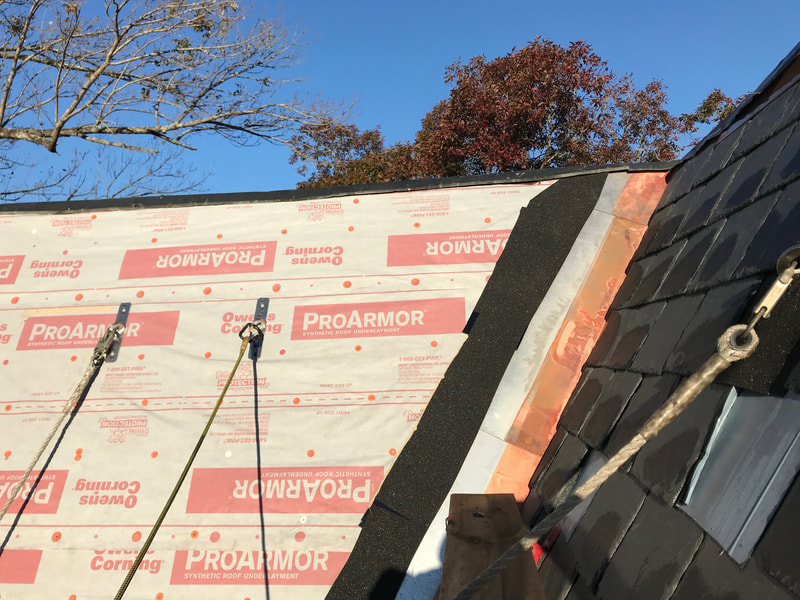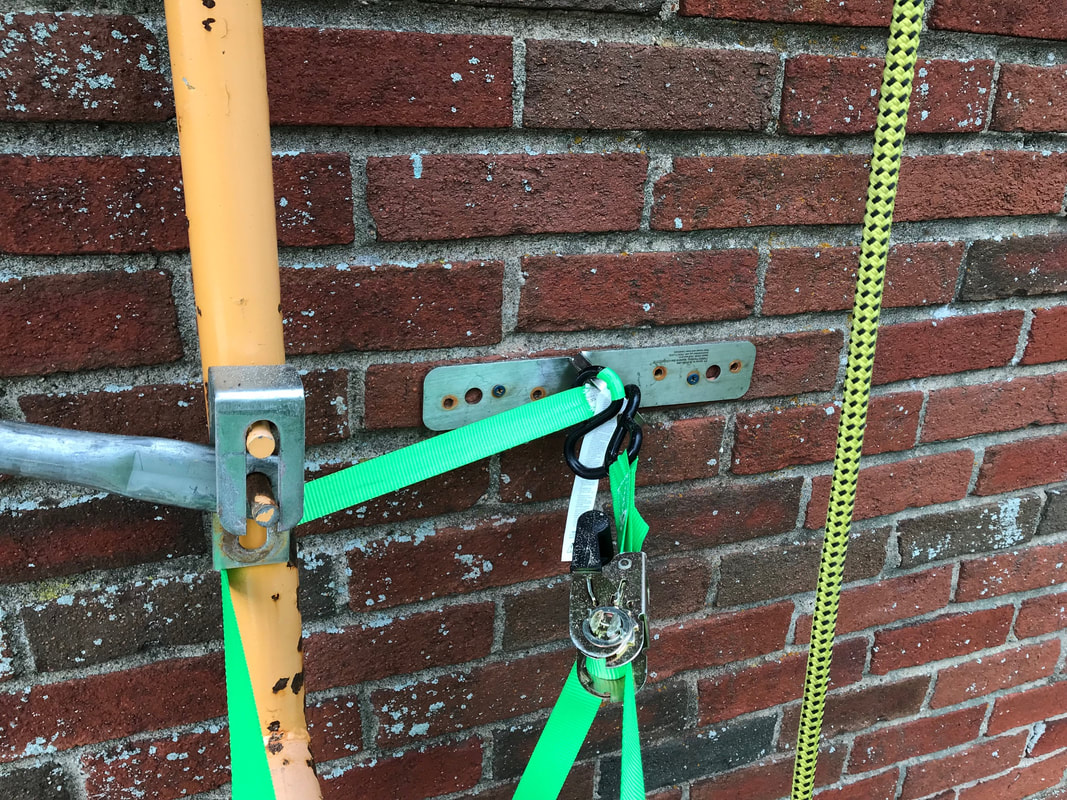Our V-Series anchors are the strongest, simplest, most durable anchors you will ever use.
The V-Series and SLATOR bracket anchors meet OSHA 1926 and 1910 requirements
and are proudly made in an ISO 9001:2015 USA facility.
(Photo Courtesy of Jenkins Slate Masters, Inc.)
The V-Series and SLATOR bracket anchors meet OSHA 1926 and 1910 requirements
and are proudly made in an ISO 9001:2015 USA facility.
(Photo Courtesy of Jenkins Slate Masters, Inc.)
TimberLok 4" Structural Wood Screws are approved fasteners for installing the V-1 anchor through the roof sheathing into a suitable roof rafter. We recommend you order these through Amazon for about $100. Use each fastener only once for installing the V-1 anchor. Discard or repurpose for a different suitable use once removed. Do not use the same fastener again for an anchor installation because they have been weakened and are no longer compliant.
What becomes your fall protection anchor once the ridge anchors have been removed? How does the roofer safely cut the ridge vent opening and install the ridge vent and cap shingles? The ridge anchors were in the way and have usually been removed. Without proper planning, the roofer is exposed to potential falls during this time consuming final task.
Why use ridge anchors . . . at all? Scroll down to compare the Pros and Cons. With the right gear, you can go anywhere.
Why use ridge anchors . . . at all? Scroll down to compare the Pros and Cons. With the right gear, you can go anywhere.
|
Ridge Anchors:
Pros: Inexpensive and disposable. Allows worker to work on either side of roof. Cons: In the way during asphalt shingle tear offs. In the way during completion of the ridge. Cannot be installed over ridge vents. Not compatible with slate roof work. Not compatible with new metal roof installations. Not designed for hip roof installation. Generally NOT designed to be used in a flat or folded "in half" position. Requires 12 - 32 fasteners per installation. Primitive welds and usually made overseas. Metal is thin, deforms easily and moving parts wear out over time. |
V-1 Anchor:
Pros: Allows worker to have fall protection in many directions. Can provide fall protection from start to completion of job. Fasteners have a smooth shank which helps user locate the rafter. Made in the USA out of 7 gauge stainless steel. TIG welded by expert, certified welders. Extremely strong, long lasting. Installs with 6 fasteners through the sheathing into a roof rafter. During repair work, only 2 shingles are affected by installation. Compatible with many roof types. Can be installed at any location on a roof in a suitable rafter. Hole centers are designed to help secure scaffolding to masonry walls. Can be laser engraved for Company ownership. Cons: Higher initial expense. Long fasteners may drain cordless drill/impact driver battery charge more quickly. User attention required to avoid improperly positioning a carabiner or connector. |
Instead of ridge anchors, we recommend strategic placement of V-5 permanent anchors. Another method is to use V-1 anchors on each roof surface during the roof tear off and installation. Generally, we recommend locating anchors 18"-24" below the ridge every 16' and 4' off the rakes. If the rake is lengthy and a large potential swing exists, we recommend using a vertical lifeline parallel to the rake (Petzl Ray rope and ASAP mobile fall arrestor) with a V-1 positioned at the top and bottom.
We also recommend the use of rope protective devices to reduce risk of damaging the ropes.
We also recommend the use of rope protective devices to reduce risk of damaging the ropes.
|
The V-1 is also an ideal anchor for securing scaffolding to the side of a masonry or wood sided building.
Relating to scaffolding: OSHA 1926.451(c)(1)(ii) Guys, ties, and braces shall be installed according to the scaffold manufacturer's recommendations or at the closest horizontal member to the 4:1 height and be repeated vertically at locations of horizontal members every 20 feet (6.1 m) or less thereafter for scaffolds 3 feet (0.91 m) wide or less, and every 26 feet (7.9 m) or less thereafter for scaffolds greater than 3 feet (0.91 m) wide. The top guy, tie or brace of completed scaffolds shall be placed no further than the 4:1 height from the top. Such guys, ties and braces shall be installed at each end of the scaffold and at horizontal intervals not to exceed 30 feet (9.1 m) (measured from one end [not both] towards the other). |
Note: Working at heights is hazardous. Always inspect your anchors, carabiners and ropes for damage before each use. It is critical to protect the rope from sharp edges and potential cuts. We prefer using an anchor on each roof surface, however, if we do work over the ridge or around a corner we recommend using a "buffer" to protect the rope from potential cuts. The V-1 is designed to be used with Petzl's triact-locking VULCAN or OXAN carabiners. Use of other connectors is discouraged and should only be done with more caution. Inattentive use of any connector may create a "binding" situation that may improperly load the connector's gate, leading to failure of the connector and a hazardous or deadly situation. Always keep your rope tight and connector oriented in a position that will load it along its major axis.









